At the October, 2013 Horticulture and Design Meeting, Dianna Dwyer presented tips on dividing perennials that she found in an article in Fine Gardening Magazine. Dividing perennials improves the health of mature plants, and also allows you to increase the number of plants to replant in your garden or to give to friends. Below is the information from the magazine.
Click here for “10 Tips on Dividing Perennials” (pdf).
Click here for “Timing of Perennial Division,” a long list showing when and how to divide each (pdf).
—————————————————————————————————————
—————————————————————————————————————
In September, 2016, Anne Cheng gave a demonstration showing the six main root types (Clumping, Fibrous, Rhizome, Spreading, Tap and Tuberous) and discussed how to divide them:
>And here is a table on “When and How to Divide Some Common Perennials” (pdf).
Plant Division by Root Type
In general, it is best to divide spring and summer blooming perennials in the fall, and fall bloomers in spring. Prepare to divide ahead of time, by watering the plants to be divided thoroughly 1-2 days before division. Prepare the new area (pitchfork) before you lift the parent plant. Prune stems and foliage to 6 inches, to ease division and decrease moisture loss.
———————————————————————————–
Root types: Clumping, Fibrous, Rhizome, Spreading, Tap and Tuberous.
Tools: hatchet, knife, pitchfork, saw, scissors, shears, spade, and trowel.
Links: (www.clemson.edu/extension/hgic/plants/landscape/flowers/hgic1150.html,
http://extension.psu.edu/plants/gardening/fact-sheets/perennial-garden/dividing-perennials)
—————————————————————————————————————
Clumping – originate from a central clump with multiple growing points. Many have thick fleshy roots. Large roots can be a solid mass and are best separated with a saw or hatchet, into smaller sections with 3-4 buds together.
{Bleeding Heart, Daylily, Hosta, Lily of the Valley, Sedum. Many large ornamental grasses}.
Best tool/s: Hatchet, Pitchfork, Shears, Spade
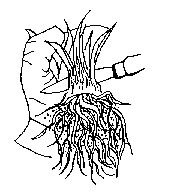
Clumping Roots
————————————————————————————————————————————————————–
Fibrous – many fine, branching hair-like roots forming a mat. Gently pull small fibrous roots apart into bits with 3-4 plants, trim damaged areas with scissors. Cut plants with woody crowns apart with knives, leaving 1-2 buds with a root part. Split masses of intermixed
crowns and roots by forcing two pitchforks through it and pry apart. After divisions, cut away old woody centers with a sharp knife, keeping smaller divisions with 5-6 buds each.
{Columbine, Ornamental Grasses, Primrose, Yarrow}
Best tool/s: Knife, Pitchfork, Scissors, Trowel
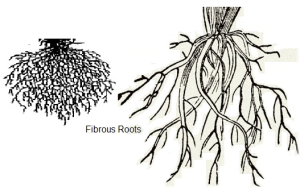
—————————————————————————————————————————————————————
Rhizomes –grow horizontally at or above the soil level. Rhizomes are easily lifted and separated into several new roots. Using a knife, slice young, 2-3” outgrowths with at least two growth buds, flush with the rootstock. Replant at the same depth as the original rootstock. (Plant bearded iris with a third of the root above ground.)
{Bearded Iris, Canna, Ferns, Ivies, Lily of the Valley}
Best tool/s: Knife, Scissors, Shears
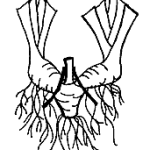
Rhizome Root
—————————————————————————————————————————————————————
Spreading – coarse, laterally growing, shallow system with
no distinct pattern Roots that grow out in any direction, from any root.
{Asters, Astilbe, Bee balm, Bellflower, Black-eyed Susan, Blanket Flower, Chrysanthemum, Cranesbill,
Lambs-ear, Purple cone-flower, Tickseed, Wormwoods, Yarrow}
Best tool/s: Knife, Pitchfork, Saw, Trowel
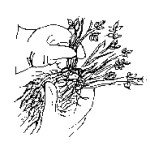
Spreading Roots – Small
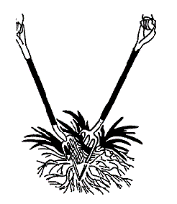
Spreading Roots – Big
—————————————————————————————————————————————————————
Tap – tapering shape, growing straight downward. Single tapering roots that extend straight down, but can intertwine if grown in clumps.
{Balloon flowers, Butterfly weeds (Asclepias), Euphorbia, Oriental poppies}
Best tool/s: Pitchfork, Spade, Trowel
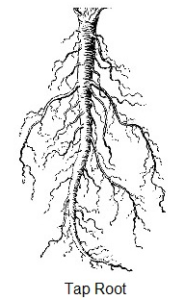
—————————————————————————————————————————————————————
Tuberous – modified lateral root, enlarged to function as storage. Every division must have a piece of the original stem and a growth bud attached. Some tuberous roots systems can be pulled apart by hand. After division they can either be replanted or stored for spring planting.
{Alliums, Anemones, Caladium, Dahlias, Peony}
Best tool/s: Knife, Shears, Trowel
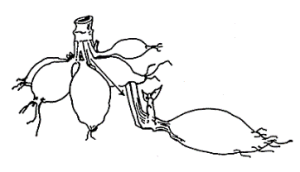
Tuberous Roots
—————————————————————————————————————————————————————
Don’t Divide These Perennials
Some plants resent being divided and it should be avoided if possible.
– Baby’s breath (Gypsophila), Butterfly weed (Asclepias), Columbines (Aquilegia), Euphorbias, False indigo (Baptisia), Japanese anemones, or Oriental poppies.
– Lenten and Christmas roses (Helleborus) are very difficult to move when more than a few years old. Usually you can find tiny, easily moved seedlings around the base.
Several other perennials are actually small woody shrubs and should not be divided, but if they have rooted layers (branches that have developed roots while touching the soil), cut them from the parent plant, dig up and replant:
– Lavender, Lavender cotton (Santolina chamaecyparrus), Perennial candytuft (Iberis sempervirens), Rosemary and several Artemesias.
